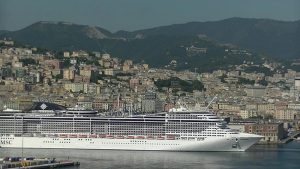 Like an amphitheater, Genoa lies against steep mountains, there is hardly a flat strip of land on the coast. The stage that the Genoese have looked out on for millennia is the sea. Agriculture, cattle-breeding, forestry were not possible, there was no space for it. Thus, they went out to sea, becoming the skillful and adventurous sailors they were known for. And notorious: Genoa was a pirate’s nest for centuries, and a center of the Mediterranean slave trade.
Like an amphitheater, Genoa lies against steep mountains, there is hardly a flat strip of land on the coast. The stage that the Genoese have looked out on for millennia is the sea. Agriculture, cattle-breeding, forestry were not possible, there was no space for it. Thus, they went out to sea, becoming the skillful and adventurous sailors they were known for. And notorious: Genoa was a pirate’s nest for centuries, and a center of the Mediterranean slave trade.
Genoa is the most important port in Italy. Throughout history, the area has been a melting pot of people that have left their mark on society. Traces of Neanderthals, dating from 40,000 BCE, and traces of the first immigrants from the Middle East, around 5000 BCE, have been found. In the sixth century BC, people settled on Castello Hill. Genoa was linked to the road system of the Roman Empire. In 146 BC, Genoa received city rights. In the following centuries, the city was constantly occupied by other people that had become adrift, such as the Goths, Byzantines, Longobards, Franks; the city was often destroyed and then rebuilt.
Around the year 1000, shipping in Genoa became important. The Genoese became aggressive sailors and pirates, scouring the shores of the Mediterranean. For example, they sailed to Alexandria and Cairo, Spain, the Middle East and the Black Sea. Aristocratic families, who would rule the city for centuries, such as the Doria, Grimaldi, Spinola, Visconti, Adorno families, grew out of these enterprising and predatory sailors and fighters. Genoa, like Pisa and arch-rival Venice, became a maritime city-state, always trying to expand its influence. The traders took products from the caravans that came from China. In 1296, the Venetian traveler and merchant Marco Polo, who had returned from China after 24 years as a wealthy man, was captured during a war with Genoa. He was imprisoned in the Palazzo San Giorgio, Genoa’s town hall, along with a storyteller and writer named Rustichello from Pisa. The men became friends, and Rustichello wrote down the wonderful stories of Marco Polo in China, and so Marco Polo’s travels were handed down around 1300.
Nearly two centuries later, Cristoforo Colombo, who was born in Genoa, took that book on his voyage of discovery across the Atlantic. He wanted to sail to the Indies, but ended up in America. In the sixteenth century, Genoa became a point of support for the Spanish empire, which looted large amounts of silver and gold from the mines in South America, but again spent the money on the many wars it fought. The Genoese rented their ships and sailors to the Spanish crown, and so a third of the American silver ended up in Genoa. With the decline of the Spanish empire, Genoa also fared less well.
From 1875, the port of Genoa was continuously expanded. Seafaring increased due to the opening of the Suez Canal. Container ports and passenger ship ports were built at the end of the 20th century. The port of nearby Savona was merged with that of Genoa. There, the Danish Maersk and the Chinese Cosco are building a new container port. Many ferries sail from Genoa to other Mediterranean ports. The cruise company Costa is located in Genoa.




